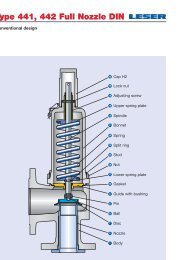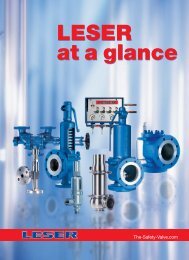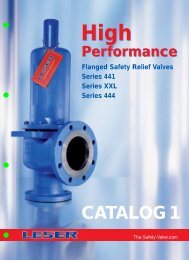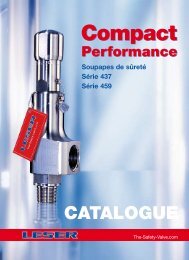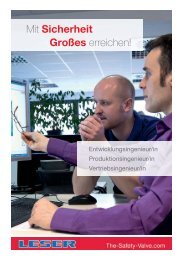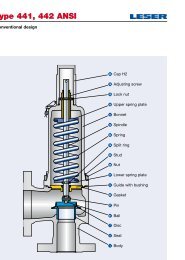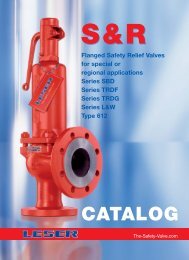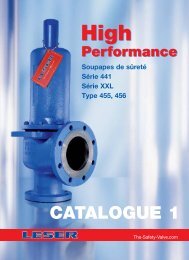Compact
Compact
Compact
- No tags were found...
Create successful ePaper yourself
Turn your PDF publications into a flip-book with our unique Google optimized e-Paper software.
How to use<br />
General<br />
7<br />
Base of capacity calculation<br />
Media<br />
Code<br />
Steam<br />
(saturated steam)<br />
Standard<br />
conditions<br />
Metric Units<br />
Capacity calculation according to<br />
AD 2000-Merkblatt A2<br />
Steam table IAPWS-IF97<br />
IAPWS Industrial Formulation for<br />
the Thermodynamic Properties<br />
of Water and Steam<br />
[kg/h]<br />
US Units<br />
Capacity calculation according to<br />
ASME Section VIII (UV)<br />
Steam table IAPWS-IF97<br />
IAPWS Industrial Formulation for<br />
the Thermodynamic Properties<br />
of Water and Steam<br />
[lb/h]<br />
Air<br />
Standard<br />
conditions<br />
0 °C and 1013 mbar [m n 3 /h] 16 °C (60 °F) [S.C.F.M.]<br />
Water<br />
Standard<br />
conditions<br />
20 °C (68 °F) [10 3 kg/h] 21 °C (70 °F) [US-G.P.M.]<br />
All Media<br />
Calculation<br />
pressure<br />
Set pressure plus 10 % overpressure<br />
Set pressure plus 10 % overpressure<br />
Calculation<br />
pressure for<br />
low set pressure<br />
Capacities at 1 bar (14,5 psig)<br />
and below are based on 0,1 bar<br />
(1,45 psig) overpressure.<br />
Capacities at 2,07 bar (30 psig)<br />
and below are based on<br />
0,207 bar (3 psig) overpressure.<br />
Example Capacity calculation pressure<br />
Metric Units<br />
US Units<br />
Set pressure Capacity calculation pressure Set pressure Capacity calculation pressure<br />
10 bar 10 bar + 10% overpressure = 11 bar 145 psig 145 psig + 10% overpressure = 159,5 psig<br />
0,5 bar 0,5 bar + 0,1 bar overpressure = 0,6 bar 20 psig 20 psig + 3 psig overpressure = 23 psig<br />
4<br />
LESER Effective Orifice<br />
Pressure relief devices may be initially sized using the equations<br />
shown in API RP 520, topic 3.6 through 3.10 as appropriate<br />
for vapors, gases, liquids, or two phase flow. These<br />
equations utilize effective coefficient of discharge (S/G 0,975,<br />
L 0,650) and effective areas (acc. to API Std. 526, Fifth Edition,<br />
June 2002, table 1) which are independent of any specific<br />
valve design. In this way the designer can determine a preliminary<br />
pressure relief valve size.<br />
By using the LESER Effective Orifice the designer can directly<br />
select a LESER safety relief valve after calculating. A verification<br />
of the sizing with the selected actual orifice and the<br />
rated coefficient of discharge is not necessary.<br />
LEO S/G<br />
LESER Effective Orifice (for steam, gas and vapor) [inch 2 ] refer to page 00/11<br />
LEO L<br />
LESER Effective Orifice (for liquid) [inch 2 ] refer to page 00/11<br />
For further information refer to LESER Engineering Handbook<br />
LWN 481.01-E<br />
00/10


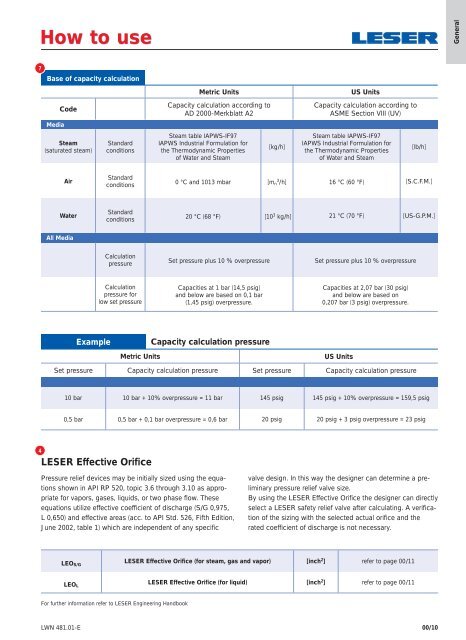
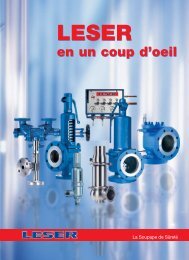
![Stückliste Type 441, 442 DIN [DE] - Leser](https://img.yumpu.com/50352159/1/189x260/stuckliste-type-441-442-din-de-leser.jpg?quality=85)
